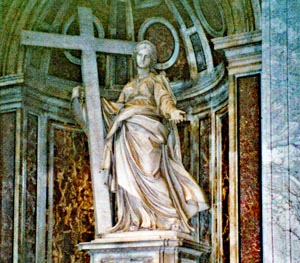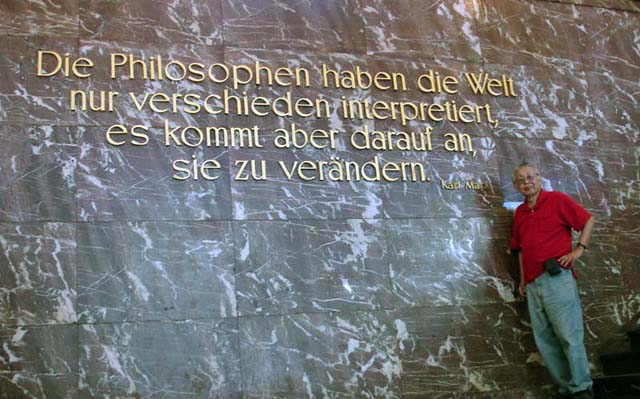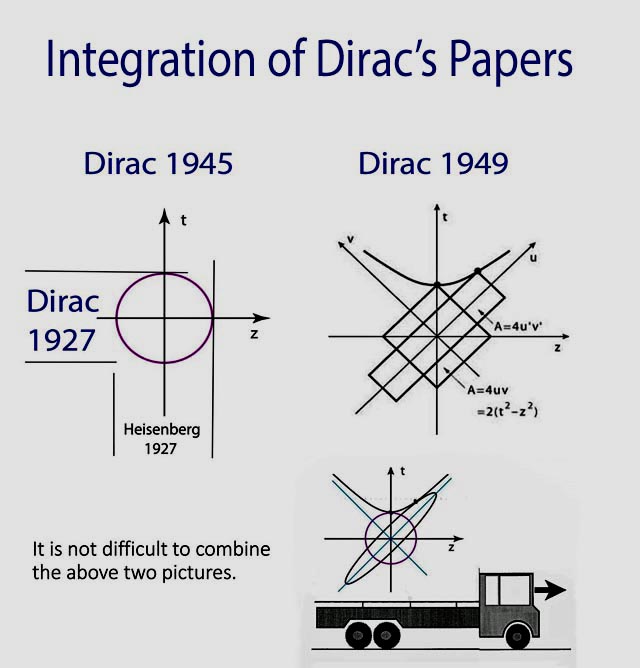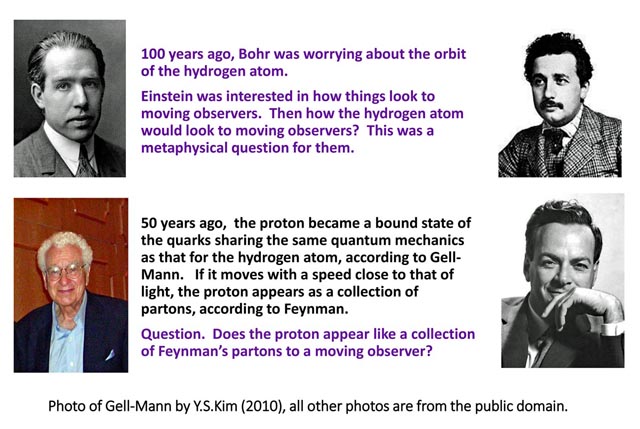Photos from Trier, Saint Helena,
Karl Marx, and E = mc2.
Have you been or heard about a small German city called
Trier? . This city is
in Germany but is very close to Luxemburg. I assume you know where
Luxemburg is. Trier is one-hour train ride from Luxemburg.
- Why should we talk about this city. Karl Marx was born and raised
in this city. Earlier in history, Saint Helena built the first Christian
church north of the Alps. Saint Helena was Emperor Constantine's mother, and
regarded as the mother of the Christian Empire. Constantine later built a
larger church in Trier, but this church was destroyed and rebuilt severl times
due to armed conflict in that area. In addition, new buildings were addes in
the same area.
- I am not a religious person, but my Korean background includes a
strong Christian background.
You may be interested in the following webpages baased on my Christian
background.
- Herod Complex. This deals with
psychological problem for every self-respecting physicist.
- How did Moses to talk to God? How can we talk to Einstein?
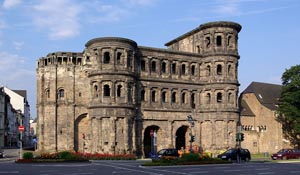

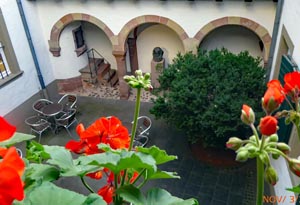
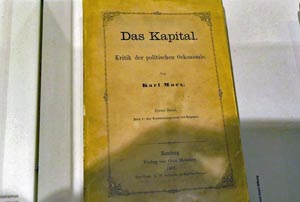
- Herod Complex. This deals with
psychological problem for every self-respecting physicist.
- Let us look at some photos from Trier.
- The first notable object is the gate to the city constructed
by Romans. Here is a photo of the
the Roman Gate.
- I then visited the tourist office. Next to this office
was a giant statue of Karl Marx.
I went to Trier to learn about Saint Helena, but I met this person responsible for God-less communist empire. The question is whether I should give up and leave the city, or study why Marx is there.
- Marx's statue is there because he was born and raised in this city.
He was born in a Jewish family, and his family belonged to an upper-middle
class in Germany.
-
These days, the political ideology called "communism" is forgotten and irrelevant,
but the city of Trier is quite proud of Marx as their distinguished son, and
his childhood house is now a Marx museum.
- The Marx Museum contains many Marx items, including
his bust at
the flower-filled quadrangle.
- Needless to say, the Museum shows a
list of prominent communists who played their role in the 20th Century.
- The Museum also shows the books Marx wrote including Das Kapital. Have you read this book. I read this book in the summer of 1956 between my sophomore and junior years in college. In Volume IV of this book, Marx introduces a new variable in economics: Surplus Value.
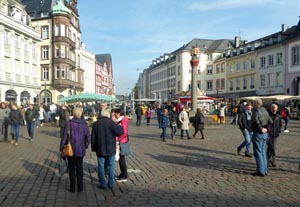
- The first notable object is the gate to the city constructed
by Romans. Here is a photo of the
the Roman Gate.
- I did not have enough time to find out how the the life style of the people in this city,
but they seem to be very happy.
- Their town square is beautiful,
- with interesting groups of people,
- also with locally grown farm products
and
flowers.
- The Trier ladies enjoy their afternoon teas.
- Click here for more photos and stories of this interesting city.



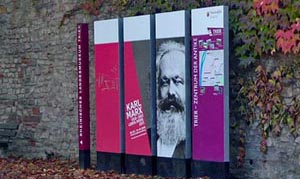
- Let us go to
the Basilica of Constantine. This church was first built by Constantine the Great
of the Roman Empire, and has a complicated history. It is said that he built this
church on the place where his mother, Saint Helena, worshipped before Constantine
declared the
Edict of Milan in 313 AD.
The original building was destroyed by armed conflicts in this area, and the building was rebuilt several times.
In addition, a new administrative building called Electoral Palace was built next to this church. I am not able to explain the role of this shiny building. You may click on this Wiki page for details. Thus, the area is now a pleasant park. Let us look at some photos. s
- This is the Basilica building.
- Plate on the outside wall telling this building is the Constantine Basilica.
- This is a side view of the Basilica.
- Inside the Basilica. This photo is from the Wikipedia.
- The Electoral Palace is an stylish modern building. The building behind with a triangular roof is the Constantine Basilica.
- Front of this building is a serene park with this kind of maze, and a reflection pond with statues of 12 Apostles.
- There is also a portrait of Karl Marx in this Christian park.
- Inside the Basilica. This photo is from the Wikipedia.
- Let us return to Karl Marx, and let us ignore his communism issues. There
are still many important items to talk about him.
Before Hitler, Humboldt University of Berlin was one of the most respected learning places in the world. Bismarck, Hegel, Marx, Planck, Einstein, and many others studied and/or taught there. As soon as you enter the main building, you see what Karl Marx said about on a marble plate.
What does he say in English? Let us go to his grave at the Highgate Cemetery in London.
- Here, Marx was taking about changing the world. We know how he wanted to
change the world. Politically? We are not interested in this aspect.
Throughout his writings, he talks about manual labors and manual laborers. After all those struggles in writings, Marx formulated the concept of "surplus value" in Volume IV of his book "Das Kapital." Marx died before this volume was published.
Before Marx, money and price were important variables in economics, but labor was not. Marx noted that there is a price differences between raw materials and finished products. He called this difference "surplus value." He then concluded that this difference in value comes from the labor contributed by manual workers. Thus, he formulated the formula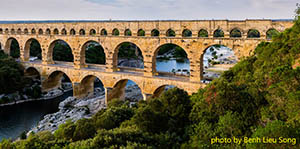
-
This is a bridge built by Romans at the time of Julius Caeser near
Avignon, France. Did they worry about the cost of labors?
-
Labor = Money .
This is one of the most important formulas in the industrial world, it was a totally strange concept before Karl Marx. When Egyptians built their pyramids, and when Romans built their water bridges, did they have this concept?
More recently, according to Mrs. Michelle Obama, the White House was built by slaves (laborers without compensation).
- Let us come back to physics. We all know Einstein formulated the
concept
E = mc2, or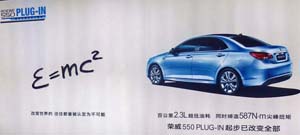
Do they know what this formula means? S 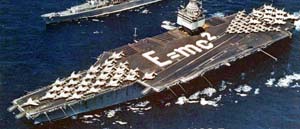
Mass = Energy.
This formula sometimes is used as an advertising purpose for being electrically powered (a car ad in Shanghai, China),or being nuclear powered (the flght deck of the nuclear aircraft carrier called USS Enterprise).
- Let us do a quantitaive analysis of this formula. You all know how
much your automobile weighs, and you think combat tanks are much heavier.
Let us look at two tanks which played their important roles in history.
The mass of each tank is about 50 metric tons. Using E = mc2 , it is possible to convert tons to joules. Indeed, one of these tanks can satisfy the total energy need for humans for one year.
|
In spite of the urgent energy need, physicists are trained to look into a smaller world.
- Let us see whether Einstein's reasoning for
E = mc2
is applicable to the interior of the hydrogen atom.

Bohr and Einstein -
In 1913 (more than one hundred years ago), Bohr was worrying
about why the energy levels of the hydrogen atom are discrete.
Einstein was worrying about how things look to moving overseers.
Did Bohr and Einstein worry about how the hydrogen atom looks to a moving observer?
There are no records to indicate that they discussed this issue. Who started worrying about this problem? His name is Paul A. Dirac.
- While quantum field theory deals with running waves with the
S-matrix as the main calculational tool, Dirac was concerned with
localized standing waves. He wrote three important papers on
this subject, but he was not able to integrate them. The reason
is very simple.
- His writings are like beautiful poems, but he never attempted
draw figures.
- In the hydrogen atom, the distance between the proton and election
is the space separation. In dealing with the time-variable, Dirac
does not specify the time separation.
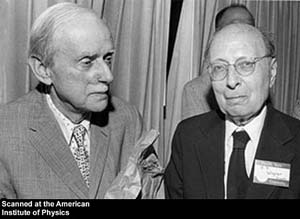
Dirac and Wigner,
brothers-in-law. - In his 1927 paper, Dirac complained that the time-energy uncertainty relation is a c-number relation (no excitations along the time-like direction). He did not know this issue was later addressed by Wigner in 1939 who introduced his little groups. The space-time symmetry of the hydrogen atom (localized wave) is like that of the three-dimensional rotation group, with no-time-like excitations.
- His writings are like beautiful poems, but he never attempted
draw figures.
- If we make up these deficiencies, we can integrate Dirac's works in the
following manner.
This figure integrate the following three papers written by Dirac.
- P. A. M. Dirac, Proc. Roy. Soc. (London) A114, 243 - 265 (1927).
- P. A. M. Dirac, Proc. Roy. Soc. (London) A183 , 284 -295 (1945).
- P. A. M. Dirac, Rev. Mod. Phys. 21, 392 - 399 (1949).
- Yes, the above figure indeed integrates these three papers. The question
is whether there are hydrogen atoms moving with relativistic speed? The
answer is No. The question then is what I said above is only a science fiction.
The answer is again No.
- The hydrogen atom is neutral, and cannot be accelerated by
a strong external electric field, but we can accelerate protons
because they are charged particles.
- During the last half of the past century, countries spent billions of
dollars to build particle accelerators. These accelerators produce
protons moving with speeds close to the speed of light.


- The hydrogen atom is neutral, and cannot be accelerated by
a strong external electric field, but we can accelerate protons
because they are charged particles.
- If the proton moves with its speed close to that of light,
it appears like a collection of partons (Feynman), whose properties
are quite different from those of the quarks. The question
is whether this difference can be explained in terms of
Einstein's special relativity and the standing-wave picture of the
quantum bound state.
- These questions constitute further contents of Einstein's
-
E = mc2.
copyright@2023, by Y. S. Kim, unless otherwise specified.
- Click here for his home page.
- His Princeton page.
- Einstein Magazine.
- Einstein's Bern,
where he formulated his special relativity leading to his
E = mc 2.
